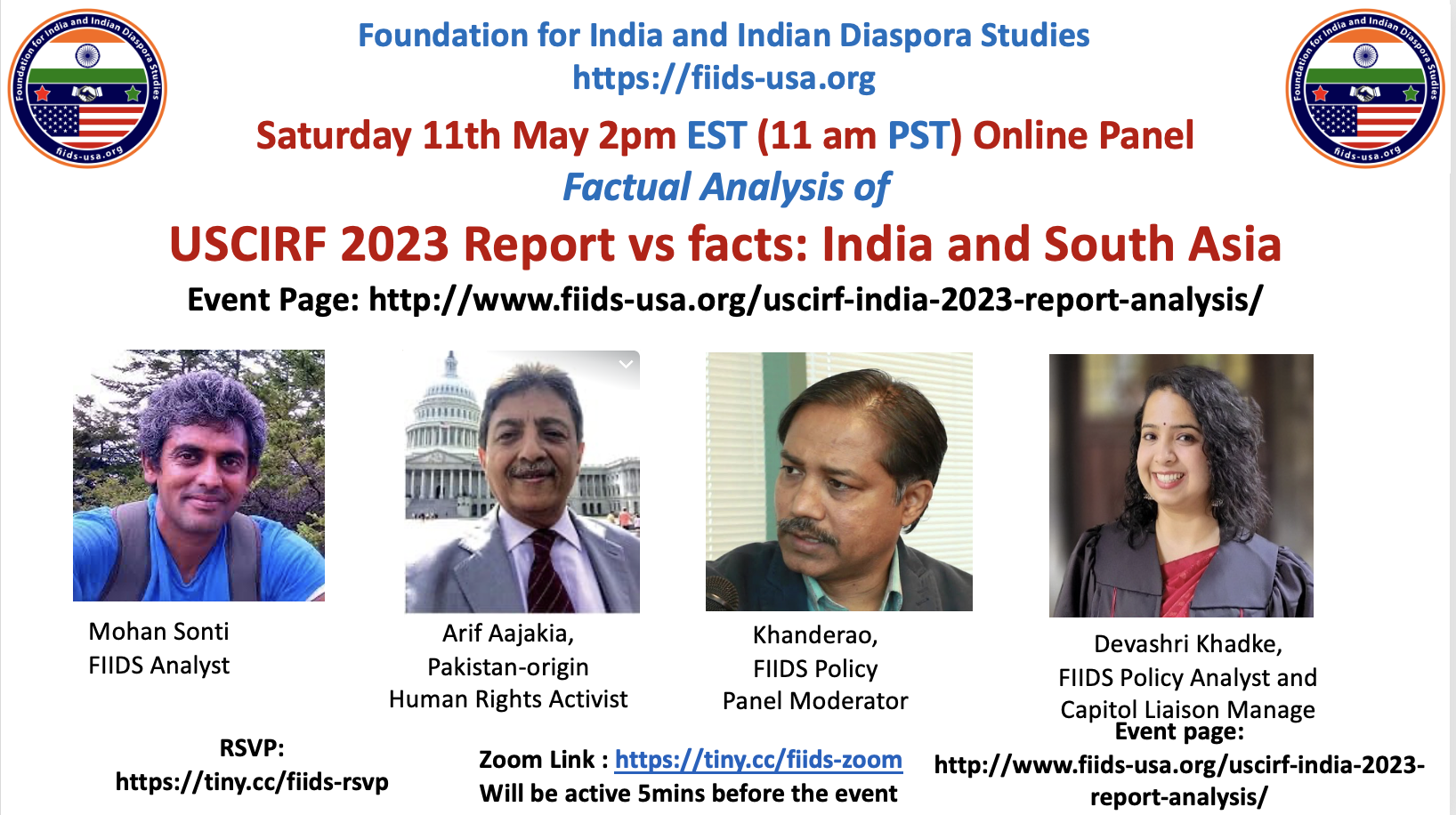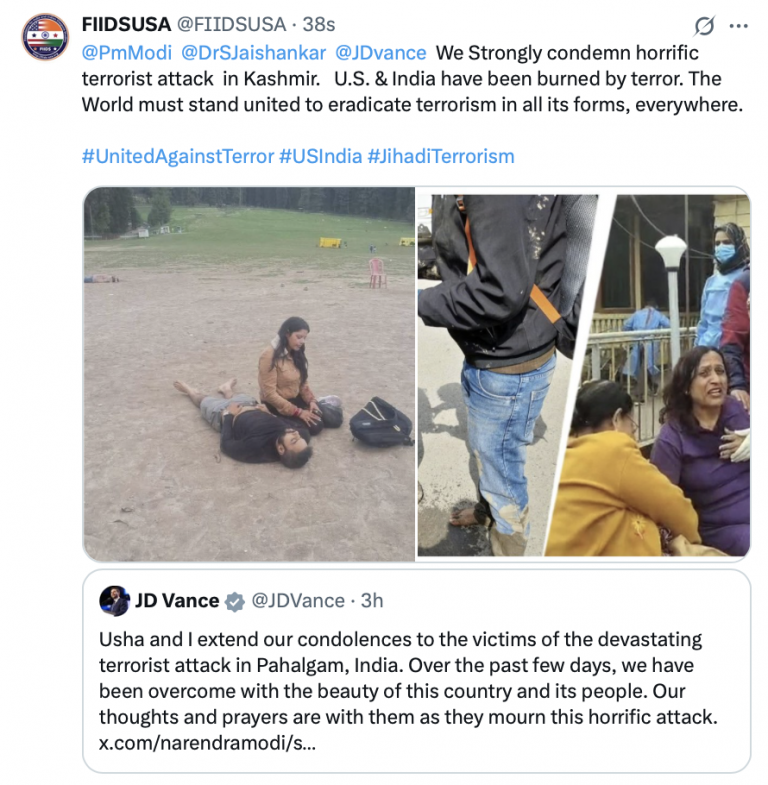
Saturday 11 May 2pm EST (11 am PST) Online Panel
Factual Analysis of
USCIRF 2023 Report vs facts: India and South Asia
Saturday 11th May 2pm EST (11 am PST) Online Panel
Topic: Factual Analysis of USCIRF 2023 Report vs facts: India and South Asia
Panelists: Arif Aajakia (Pakistan-origin Human Rights Activist), Mohan Sonti (FIIDS Analyst), Devashri Khadke (FIIDS Analyst and Liaison Manager), Khanderao Chief of Policy and Strategy
RSVP: https://tiny.cc/fiids-rsvp Event Closed
Zoom Link (5 mins before the event) : https://tiny.cc/fiids-zoom
Event Page: http://www.fiids-usa.org/uscirf-india-2023-report-analysis/
Press Release: FIIDS recommends that the US Department of State should carefully evaluate and reject USCIRF biased analysis and flawed recommendations.
The Foundation for India and Indian Diaspora Studies has characterized the USCIRF report as biased, presenting partial data and flawed conclusions. Khanderao Kand, Chief of Policy and Strategy at FIIDS, stated that the USCIRF report is based on omission and commission of facts, utilizing partial data, hiding the full context, generalizing isolated incidents, and questioning the implementation of the law of the land. This report used partial and isolated incidents to wrongly brand the largest democracy in the world with a population of 1.4 billion, missing the opportunity to indicate positive recent trends against the background of a complex and violent past history. Khanderao further mentioned that the USCIRF is wrong to recommend the largest democracy and largely peaceful civilization as a country of particular concern. Moreover, its is highly questionable recommendation asking to evaluate India under FATF especially when India itself has been a target of terrorism.
FIIDS Analyst Mohan Sonti from Boston mentioned that USCIRF’s position on India contrasts with FIIDS’s analysis of 2023, indicating significant year-over-year improvement.
To support FIIDS’ conclusions, we contrasted some key mentions from the report:
- FIIDS’ analysis concluded that the Manipur riots were inter-tribal, resulting from historical rivalry exploited by drug mafias and Myanmar infiltrators, impacting all religions. However, the USCIRF only singled out Christians. Moreover, we contrasted this with the position of the Archbishop of Bombay. For facts, refer to http://tiny.cc/FIIDS-Manipur-Report.
- The report wrongly held India responsible for implementing the Foreign Contribution Regulation Act (FCRA), preventing illegal and improper use of foreign funding. Why can’t NGOs follow reporting and usage laws?
- The report failed to mention India’s constitutional guarantee to freedom of religion, with prohibitions on coercive, fraudulent, and forced conversion. Instead, it complained about the enforcement of laws trying to protect gullible, underprivileged people.
- As there were no major Hindu-Muslim riots in India in 2023, instead of mentioning it as a year free of such riots, the report presented isolated incidents to generalize and brand without acknowledging India’s large Muslim population.
- The report blew out minor and isolated acts of so-called cow vigilantism, which were triggered due to cow thefts and hurting Hindu religious sentiments. Even though the police filed cases against cow vigilantes, the report failed to mention it.
- The report then mentioned “Love Jihad” as a case against conversion instead of a case against women, where 10+ Hindu-Christian girls were killed post-conversion and marriage in 2023.
FIIDS’ raises doubts and questions regarding any influence or agenda against the third-largest economy and a strong ally of the US. Considering the consequential nature of US-India relations in 2021, FIIDS recommends that the US Department of State should carefully evaluate and reject USCIRF recommendations.
Media Coverage / Press Coverage:
https://www.newindiaabroad.com/news/diaspora-body-urges-state-dept-to-reject-uscirf-report
https://indialife.us/article.php?id=226538
Detailed Report from analysis of USCIRF report of year 2023 on India from FIIDS :
- Hindu Muslim Riots
India, unfortunately, has a long history of violent Hindu Muslims riots going back over a century e.g. Mopalah [1] (Hindu Genocide of 1921 – 2500 died), Bhagalpur [2] (1000 dead), Kashmir [3] 1990 (Kashmiri Pandit Genocide), e.t.c, mostly under earlier and different regimes than the current government. In contrast to its neighboring countries, minorities in India are largely growing in their population – Muslim population from ~7% in 1951 [4] to ~14.2% in 2023 [5], making ~200 million). The riot situation in India in the year 2023 has been at a ‘Historically [6] Low’ level since independence as per the official data. The trend of the last 5 years also indicates a steady decline in communal riots in the country. In the ‘Global Peace Index’ [7] ranking, India stood at 126 among 163 countries in 2023. To put this index into a comparative perspective, India ranked 143 in 2014 and jumped to the 126th position, while in the same period, the USA was ranked 101 in 2014 [8] and 131 in 2023.
————————————————–
- FCRA – Foreign Contribution Regulation Act
The Foreign Contribution [9] (Regulation) Act (FCRA) was originally enacted in 1976 to regulate foreign contributions and to create a system for monitoring such funds within India. Over the years, the FCRA has seen several amendments that have expanded its scope, introducing more stringent regulations, procedures, and enforcement mechanisms for the nonprofit sector. In 2010, the original act was repealed and replaced with new comprehensive legislation aimed at prohibiting the acceptance and use of foreign contributions or hospitality for activities detrimental to national interests. In September [10] 2020, India amended the FCRA again to further enhance the safety and security measures within this regulatory framework. Under the amended act, NGOs and associations registered under the FCRA are required to annually declare details of both movable and immovable assets acquired through foreign contributions. Registration under the FCRA, necessary for receiving foreign funds, is initially valid for five years and can be renewed if all conditions are met. The Ministry of Home Affairs has extended [11] the deadline for NGOs to renew their licenses multiple times since 2021. Contrary to widespread misinformation, the government of India did not suspend the licenses of 6000 NGOs. Instead, 5,789 organizations [12] failed to apply for license renewal necessary for receiving foreign funding, and the licenses of 179 organizations were canceled due to violations of the act after document scrutiny. There are more than 3 million [13] NGOs in India working for different causes and the law applies to all of them.
CBI (Central Bureau of Investigation), India registered [14] an FCRA violation case against the firm NewsClick in Oct 2023. The Delhi Police alleged that Neville Roy Singham, an active member of the propaganda department of the Communist Party of China, fraudulently infused funds. Based on a New York Times investigation [15], Mr. Singham collaborates closely with the Chinese government media apparatus and is financing its propaganda efforts globally.
There are similar provisions of income reporting across the globe, including the US. Under federal law in the USA, tax-exempt nonprofits governed by Section 501 of the Internal Revenue Code must submit annual [16] financial reports to the Internal Revenue Service (IRS) using IRS Form 990. Schedule B of this form requires nonprofits to report information about their significant donors (more than $5,000), including their names and contribution amounts. Additionally, these forms must provide details about the organization’s income, expenses, assets, and activities, offering transparency into their financial operations. However, the extent of the disclosure may vary based on the organization’s tax-exempt status, size, and other factors.
————————————————–
- Manipur Conflict
Row over ‘Affirmative [17] Action’ led to violence in May 2023 between two ethnic communities in the state of Manipur resulting in 219 deaths [18] with several thousand people displaced. The Indian government invoked Article 355 of the constitution [19] and deployed the Paramilitary to bring the situation under control. Manipur is a northeastern state in India known for its rich cultural heritage, long complex history, and diverse culture of various tribes, mainly, Meitei, Kuki, and Naga. While the state has a long history ( Kuki-Naga clashes [20] (1992-1997), Meitei-Kuki clashes (1992), Churachandpur [21](1997)) of inter-tribal conflicts and decades-long separatist terrorism, which had subsided in recent years, the roots of the violence in 2023 between the Meitei and Kuki communities stem from multifaceted factors such as historical grievances, economic disparities, and conflicts over rights. Though some Western media projected this as a religious conflict, it was clearly a tribal/ethnic [22] one. The Archbishop of Bombay, Cardinal Oswald Gracias, said [23], “ This is a tribal conflict between two tribes, historically very hostile to each other. And it exploded into violence because of certain legislation that was passed. It has been given a religious twist, but it is not a religious conflict. It is not between two religions, it’s between two tribes”. The Western media also strategically omit the fact that along with churches, 393 Meitei [24] temples and shrines were destroyed and burnt by Kuki militants.
In Feb 2024, the Manipur High Court rescinded [25] its directive to the state government to deliberate on incorporating the Meitei community into the Scheduled Tribes (STs) list. Recently, repolling [26] concluded in six booths of the Outer Manipur constituency, completing voting for the 2024 Lok Sabha election. The repolling proceeded peacefully, with all six stations recording a high voter turnout of 81.16%. These polling stations, situated across three assembly segments of Ukhrul, Chingai, and Karong, had experienced disturbances on April 26, prompting the Election Commission of India to order the repoll.
————————————————–
- Cow Slaughter Vigilante
Meat from certain animals are considered taboo to consume in different civilizations. For example, eating dogs is considered a taboo and practically banned in most of Europe and America. However, dog meat [27] was a common food in most of Europe and is still common in several countries like China, Korea, etc where they have festivals for the same. However, India is one of few countries to have officially and legally banned eating dogs with the ‘Prohibition of Dog Meat Consumption’ enacted in India through the Food Safety and Standard (Food Products Standard and Additives) Regulation [28], 2011. When it comes to cattle, as of 2023, about 20 States [33] in India have enacted laws restricting or banning the slaughtering of Cattle.
India as a country has the highest percentage of vegetarians at about [29] 40%, which is about an order of magnitude higher than the country coming in second place. India has also been an agrarian society for thousands of years and largely still is, with over 70% rural population still dependent [30] on it.
The number of Cow Slaughter vigilantism incidents reported in 2023 is in the low single digits across the country. There have also been a lot of cases of cattle [31] theft in India, where cattle thieves from Bangladesh stole cattle from neighboring Indian villages [32]. There are some anecdotal reports of clashes with criminals illegally sending the cows for slaughtering, with the ones stopping the criminals being often dubbed as being ‘vigilantes’ by the media. Local police have filed charges [34] against the accused vigilantes in all the known reported incidents. However, these conclusions of the events are not often reported in the media.
————————————————–
- Anti Conversion Laws
Article 25 [35] of the Constitution of India states that “all persons are equally entitled to freedom of conscience and the right freely to profess, practice and propagate religion.” India’s commitment to these principles is further reinforced by its endorsement of the International Covenant on Civil and Political Rights (ICCPR) [36], which emphasizes the prohibition of coercion that interferes with an individual’s religious freedom, as outlined in Article 18 [36].
The term ‘Love Jihad’ originated from Kerala Churches [37], alleging that Muslim men were enticing [38] Christian women into relationships for nefarious purposes, including recruitment by Islamic terror organizations or conversion. These alarming activities drew the attention [39] of State High Courts, prompting them to enact specific laws safeguarding women’s rights [40] and preventing coercion. Instances of forced conversions have been reported, including cases where Hindu women [41] were murdered by their Muslim spouses due to their refusal to convert. Similar issues of forced conversions are prevalent in neighboring countries [42] as well.
To combat forced conversions and protect vulnerable individuals, 11 states [43] in India have implemented laws aligned with the ‘Protection of Right to Freedom of Religion’. These laws prohibit conversions [44] to another religion through force or deception, making such actions illegal. They cover a wide range of deceptive methods, including coercion, undue influence, compulsion, and allurement. Additionally, the laws enable victims of unlawful religious conversions, as well as their relatives, to file police complaints, ensuring appropriate legal recourse against such violations of religious freedom.
————————————————–
- Article 370
In Aug 2019, the Indian government abrogated [45] Article 370 that gave special status to Jammu and Kashmir. Many opposition parties also backed [45] this decision. However, the Western media continuously condemned [46] the move, even calling for external interventions and predicting that the situation could only worsen [47]. However, the reality on-ground is quite the opposite. The Supreme Court of India unanimously upheld [48] the decision to abrogate Article 370 as constitutional, and observed that it was only a temporary provision [49]. The overall law and order situation [50], and incidences of violence have drastically reduced [51] since Article 370’s removal. The Central government has also announced several infrastructure development [52] projects. The private investment proposals have also increased 5 times [51] in just 4 years compared to total investments since India’s independence.
References
| [1] | “The Australia Today,” [Online]. Available: https://www.theaustraliatoday.com.au/hundred-years-of-moplah-hindu-genocide-of-1921-how-thousands-of-hindus-were-slaughtered/. |
| [2] | “NDTV,” August 2015. [Online]. Available: https://www.ndtv.com/india-news/those-who-had-power-to-act-abandoned-the-quest-says-inquiry-report-on-1989-bhagalpur-riots-1204965. |
| [3] | “Hindustan Times,” September 2019. [Online]. Available: https://www.hindustantimes.com/columns/the-many-tragedies-of-the-kashmiri-pandits/story-8QKwIRf8ZrsfxhXlqwUEMM.html. |
| [4] | “Pew Research,” September 2021. [Online]. Available: https://www.pewresearch.org/religion/2021/09/21/population-growth-and-religious-composition/. |
| [5] | “The economic times,” July 2023. [Online]. Available: https://economictimes.indiatimes.com/news/india/muslim-population-in-india-is-nearly-20-crore-in-2023-govt-in-lok-sabha/articleshow/102011439.cms?from=mdr. |
| [6] | “BBC,” January 2023. [Online]. Available: https://www.bbc.com/news/world-asia-india-64183181. |
| [7] | “Global Peace Index,” 2023. [Online]. Available: https://www.visionofhumanity.org/wp-content/uploads/2023/06/GPI-2023-Web.pdf. |
| [8] | “Global Peace Index,” 2014. [Online]. Available: https://www.economicsandpeace.org/wp-content/uploads/2015/06/2014-Global-Peace-Index-REPORT_0-1.pdf. |
| [9] | “CAF America,” March 2023. [Online]. Available: https://cafamerica.org/blog/a-changing-philanthropic-landscape-in-india/. |
| [10] | “The Gazette of India,” September 2020. [Online]. Available: https://fcraonline.nic.in/home/PDF_Doc/fc_amend_07102020_1.pdf. |
| [11] | “CAF America,” March 2024. [Online]. Available: https://cafamerica.org/alert/india-fcra-extension/. |
| [12] | “Hindustan Times,” January 2022. [Online]. Available: https://www.hindustantimes.com/business/no-foreign-funding-for-over-6-000-ngos-whose-fcra-license-expired-mha-data-101641029019401.html. |
| [13] | “Statistica,” 2024. [Online]. Available: https://www.statista.com/statistics/1414435/india-number-of-registered-ngos-by-state-and-union-territory/. |
| [14] | “Business Standard,” 11 October 2023. [Online]. Available: https://www.business-standard.com/companies/news/fcra-violations-case-cbi-searches-at-residence-of-newsclick-founder-123101100209_1.html. |
| [15] | “New York Times,” 10 August 2023. [Online]. Available: https://www.nytimes.com/2023/08/05/world/europe/neville-roy-singham-china-propaganda.html. |
| [16] | “Ballot Pedia,” [Online]. Available: https://ballotpedia.org/Donor_privacy_and_disclosure_policy_in_California#:~:text=Although%20the%20federal%20government%20did,registered%20as%20a%20charitable%20organization.. |
| [17] | “Indian Express,” 28 April 2023. [Online]. Available: https://indianexpress.com/article/political-pulse/northeast-meitei-st-demand-manipur-hc-8581664/. |
| [18] | “Scroll,” 29 February 2024. [Online]. Available: https://scroll.in/latest/1064482/manipur-219-killed-in-ethnic-violence-since-may-10000-firs-registered-says-governor. |
| [19] | “The Wire,” 23 January 2024. [Online]. Available: https://thewire.in/government/manipur-cm-biren-singh-confirms-imposition-of-article-355-draws-flak-over-secrecy. |
| [20] | “The Indian Express,” 15 September 2018. [Online]. Available: https://indianexpress.com/article/north-east-india/manipur/kukis-started-1992-kuki-naga-ethnic-conflict-says-nscn-im-5358206/. |
| [21] | [Online]. Available: https://www.satp.org/satporgtp/countries/india/states/manipur/timeline/year_1997.htm. |
| [22] | “The Hindu,” 16 July 2023. [Online]. Available: https://www.thehindu.com/news/cities/Delhi/manipur-violence-is-not-about-one-community-attacking-christians-meitei-christian-body/article67084159.ece. |
| [23] | “The Republic World,” [Online]. Available: https://www.republicworld.com/india/manipur-violence-tribal-clash-not-religious-conflict-cardinal-oswald-gracias-articleshow/?amp=1. |
| [24] | “The Sanghai Express,” 14 August 2023. [Online]. Available: https://www.thesangaiexpress.com/Encyc/2023/8/14/Certainly-not-all-but-certain-important-points-are-beginning-to-fall-in-place-Ever-since-the-descration-or-d.html. |
| [25] | “The Economic Times,” 22 February 2024. [Online]. Available: https://economictimes.indiatimes.com/news/india/manipur-high-court-deletes-verdict-para-that-led-to-ethnic-violence/articleshow/107922427.cms?from=mdr. |
| [26] | “The Hindu,” April 2024. [Online]. Available: https://www.thehindu.com/elections/lok-sabha/out-manipur-lok-sabha-seat-repolling-voting-percentage/article68123952.ece. |
| [27] | [Online]. Available: https://www.preussenspitz.de/critical-matters/history-of-dog-eating/#:~:text=It%20was%20not%20until%201986,like%20to%20eat%20dogs%20meat.. |
| [28] | “Food Safety and Standards Authority of India,” [Online]. Available: https://www.fssai.gov.in/cms/food-safety-and-standards-regulations.php. |
| [29] | “Pew Research Center,” July 2021. [Online]. Available: https://www.pewresearch.org/short-reads/2021/07/08/eight-in-ten-indians-limit-meat-in-their-diets-and-four-in-ten-consider-themselves-vegetarian/. |
| [30] | “Food and Agriculture Organization of United Nations,” [Online]. Available: https://www.fao.org/india/fao-in-india/india-at-a-glance/en/. |
| [31] | “OP India,” September 2018. [Online]. Available: https://www.opindia.com/2018/09/the-big-picture-view-of-cattle-related-violence-in-india-it-is-more-than-what-meets-the-eye/#google_vignette. |
| [32] | “The New York Times,” 2013. [Online]. Available: https://www.nytimes.com/2013/05/27/world/asia/cow-thefts-on-the-rise-in-india.html. |
| [33] | “News 18,” [Online]. Available: https://www.news18.com/news/india/states-where-cow-slaughter-is-banned-so-far-and-states-where-it-isnt-1413425.html. |
| [34] | “India Today,” 20 June 2023. [Online]. Available: https://www.indiatoday.in/india/story/kick-and-put-cow-vigilantes-in-jail-karnataka-minister-tells-cops-ahead-of-eid-ul-adha-2395558-2023-06-20. |
| [35] | [Online]. Available: https://indiankanoon.org/doc/631708/. |
| [36] | “United Nations,” [Online]. Available: https://www.ohchr.org/en/instruments-mechanisms/instruments/international-covenant-civil-and-political-rights. |
| [37] | “Deccan Herald,” 15 January 2020. [Online]. Available: https://www.deccanherald.com/india/kerala-church-says-love-jihad-is-real-claims-christian-women-being-lured-into-is-trap-794814.html. |
| [38] | “India Today,” September 2021. [Online]. Available: https://www.indiatoday.in/india/story/killing-non-muslims-kerala-bishop-love-jihad-narcotic-controversy-church-address-1851067-2021-09-09. |
| [39] | “Rediff,” [Online]. Available: https://m.rediff.com/news/report/is-love-jihad-terrors-new-mantra/20091014.htm. |
| [40] | “The Economic Times,” December 2009. [Online]. Available: https://economictimes.indiatimes.com/news/politics-and-nation/kerala-hc-asks-govt-to-frame-laws-to-stop-love-jihad/articleshow/5320856.cms?utm_source=contentofinterest&utm_medium=text&utm_campaign=cppst. |
| [41] | “Hindu Post,” [Online]. Available: https://hindupost.in/crime/60-cases-of-murder-of-hindu-girls-by-muslim-men/. |
| [42] | “Business Standard,” April 2024. [Online]. Available: https://www.business-standard.com/world-news/un-experts-condemn-forced-marriages-religious-conversions-in-pak-124041200508_1.html. |
| [43] | “Hindutva Watch,” May 2022. [Online]. Available: https://hindutvawatch.org/karnatakas-anti-conversion-law-a-big-letdown-for-christians/. |
| [44] | “LSE,” November 2021. [Online]. Available: https://blogs.lse.ac.uk/southasia/2021/11/08/religious-freedom-and-the-anti-conversion-statute-in-india/. |
| [45] | “BBC,” August 2019. [Online]. Available: https://www.bbc.com/news/world-asia-india-49250594. |
| [46] | “The New York Times,” October 2019. [Online]. Available: https://www.nytimes.com/2019/10/02/opinion/editorials/kashmir-india-pakistan-un.html. |
| [47] | “The Guardian,” August 2019. [Online]. Available: https://www.theguardian.com/world/2019/aug/05/india-cancellation-of-kashmir-special-status-will-have-consequences. |
| [48] | “Supreme Court Observer,” December 2023. [Online]. Available: https://www.scobserver.in/reports/abrogation-of-article-370-judgement-summary/. |
| [49] | “The Hindu,” December 2023. [Online]. Available: https://www.thehindu.com/news/national/supreme-courts-verdict-abrogation-of-article-370-explained/article67626973.ece. |
| [50] | “First Post,” August 2023. [Online]. Available: https://www.firstpost.com/explainers/article-370-abrogation-has-security-situation-improved-in-jammu-and-kashmir-12961842.html. |
| [51] | “Deccan Herald,” August 2023. [Online]. Available: https://www.deccanherald.com/india/what-changed-in-kashmir-in-four-years-after-abrogation-of-article-370-1243830.html. |
| [52] | “The Hindu,” February 2024. [Online]. Available: https://www.thehindu.com/news/national/pm-modi-launches-32000-crore-worth-development-projects-in-jammu-kashmir/article67866296.ece. |




